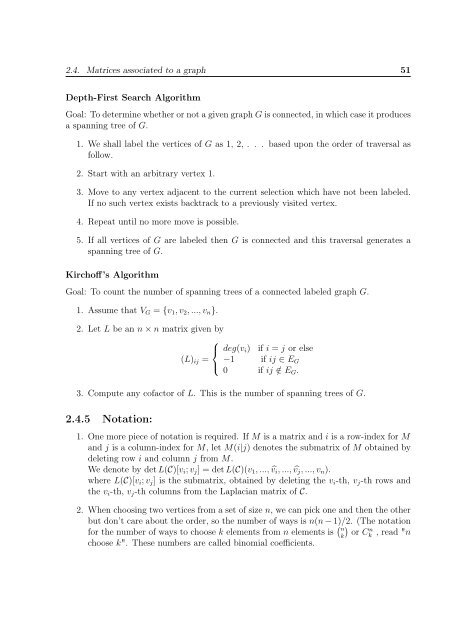enumeration of the number of spanning trees in some ... - Toubkal
enumeration of the number of spanning trees in some ... - Toubkal
enumeration of the number of spanning trees in some ... - Toubkal
You also want an ePaper? Increase the reach of your titles
YUMPU automatically turns print PDFs into web optimized ePapers that Google loves.
2.4. Matrices associated to a graph 51Depth-First Search AlgorithmGoal: To determ<strong>in</strong>e whe<strong>the</strong>r or not a given graph G is connected, <strong>in</strong> which case it producesa <strong>spann<strong>in</strong>g</strong> tree <strong>of</strong> G.1. We shall label <strong>the</strong> vertices <strong>of</strong> G as 1, 2, . . . based upon <strong>the</strong> order <strong>of</strong> traversal asfollow.2. Start with an arbitrary vertex 1.3. Move to any vertex adjacent to <strong>the</strong> current selection which have not been labeled.If no such vertex exists backtrack to a previously visited vertex.4. Repeat until no more move is possible.5. If all vertices <strong>of</strong> G are labeled <strong>the</strong>n G is connected and this traversal generates a<strong>spann<strong>in</strong>g</strong> tree <strong>of</strong> G.Kirch<strong>of</strong>f’s AlgorithmGoal: To count <strong>the</strong> <strong>number</strong> <strong>of</strong> <strong>spann<strong>in</strong>g</strong> <strong>trees</strong> <strong>of</strong> a connected labeled graph G.1. Assume that V G = {v 1 , v 2 , ..., v n }.2. Let L be an n × n matrix given by⎧⎨ deg(v i ) if i = j or else(L) ij = −1 if ij ∈ E G⎩0 if ij /∈ E G .3. Compute any c<strong>of</strong>actor <strong>of</strong> L. This is <strong>the</strong> <strong>number</strong> <strong>of</strong> <strong>spann<strong>in</strong>g</strong> <strong>trees</strong> <strong>of</strong> G.2.4.5 Notation:1. One more piece <strong>of</strong> notation is required. If M is a matrix and i is a row-<strong>in</strong>dex for Mand j is a column-<strong>in</strong>dex for M, let M(i|j) denotes <strong>the</strong> submatrix <strong>of</strong> M obta<strong>in</strong>ed bydelet<strong>in</strong>g row i and column j from M.We denote by det L(C)[v i ; v j ] = det L(C)(v 1 , ..., ̂v i , ..., ̂v j , ..., v n ).where L(C)[v i ; v j ] is <strong>the</strong> submatrix, obta<strong>in</strong>ed by delet<strong>in</strong>g <strong>the</strong> v i -th, v j -th rows and<strong>the</strong> v i -th, v j -th columns from <strong>the</strong> Laplacian matrix <strong>of</strong> C.2. When choos<strong>in</strong>g two vertices from a set <strong>of</strong> size n, we can pick one and <strong>the</strong>n <strong>the</strong> o<strong>the</strong>rbut don’t care about <strong>the</strong> order, so <strong>the</strong> <strong>number</strong> <strong>of</strong> ways is n(n − 1)/2. (The notationfor <strong>the</strong> <strong>number</strong> <strong>of</strong> ways to choose k elements from n elements is ( nk)or Cnk , read "nchoose k". These <strong>number</strong>s are called b<strong>in</strong>omial coefficients.

















